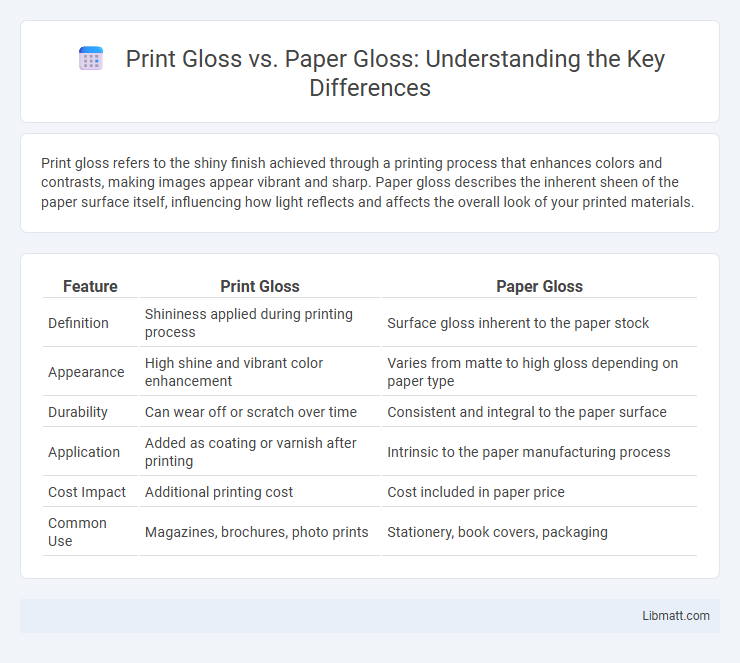Print gloss refers to the shiny finish achieved through a printing process that enhances colors and contrasts, making images appear vibrant and sharp. Paper gloss describes the inherent sheen of the paper surface itself, influencing how light reflects and affects the overall look of your printed materials.
Table of Comparison
| Feature | Print Gloss | Paper Gloss |
|---|---|---|
| Definition | Shininess applied during printing process | Surface gloss inherent to the paper stock |
| Appearance | High shine and vibrant color enhancement | Varies from matte to high gloss depending on paper type |
| Durability | Can wear off or scratch over time | Consistent and integral to the paper surface |
| Application | Added as coating or varnish after printing | Intrinsic to the paper manufacturing process |
| Cost Impact | Additional printing cost | Cost included in paper price |
| Common Use | Magazines, brochures, photo prints | Stationery, book covers, packaging |
Understanding Print Gloss and Paper Gloss
Print gloss refers to the shine or finish applied directly to printed materials, enhancing color vibrancy and visual appeal, while paper gloss describes the innate sheen of the paper surface before printing. Understanding the difference between print gloss and paper gloss is crucial for achieving your desired aesthetic and ensuring proper light reflection on your final product. Selecting the appropriate gloss level impacts not only appearance but also tactile experience and durability.
Key Differences Between Print Gloss and Paper Gloss
Print gloss refers to the shiny finish applied to printed images or text using varnishes or coatings, enhancing color vibrancy and contrast, while paper gloss describes the inherent surface shine of the paper itself before printing. Print gloss can be customized through various gloss levels such as matte, satin, or high-gloss, impacting the printed output's texture and reflectivity, whereas paper gloss is determined by the paper manufacturing process and coating. Understanding these differences allows you to select the ideal combination for your project's aesthetic and functional needs, balancing durability and visual appeal.
How Print Gloss Impacts Visual Appearance
Print gloss enhances visual appearance by intensifying color vibrancy and depth, making images appear sharper and more dynamic. The level of gloss can influence light reflection, with higher gloss surfaces creating striking highlights and richer contrast. Your choice between print gloss and paper gloss affects the final look, as print gloss directly alters the image's finish, while paper gloss pertains to the substrate's inherent shine.
The Role of Paper Gloss in Print Quality
Paper gloss significantly influences print quality by affecting color vibrancy and sharpness, as higher gloss levels enhance light reflection and image clarity. Glossy papers tend to produce deeper contrast and richer color saturation, making printed images appear more vivid and detailed. Choosing the appropriate paper gloss finish balances visual appeal with suitability for the intended print application and viewing conditions.
Advantages of Using Print Gloss Finishes
Print gloss finishes enhance visual appeal by providing vibrant colors and sharper image contrast, making printed materials more eye-catching. The reflective surface improves durability by protecting prints from scratches, moisture, and UV damage, extending their lifespan. Gloss finishes also create a professional and high-quality look, ideal for marketing materials such as brochures, business cards, and product packaging.
When to Choose Paper Gloss Over Print Gloss
Choose paper gloss over print gloss when durability and overall surface shine are priorities for your project, as paper gloss provides a more consistent, long-lasting finish. Paper gloss enhances colors and sharpness naturally, making it ideal for high-quality photos or detailed graphics that need a polished look. Your decision should reflect the desired tactile experience and the environment where the printed material will be used, favoring paper gloss for flyers, brochures, or packaging requiring a durable, vibrant appearance.
Factors Influencing Gloss Selection in Printing
Factors influencing gloss selection in printing include the desired aesthetic impact, the type of ink used, and the paper's surface texture. Print gloss enhances color vibrancy and detail sharpness, while paper gloss affects light reflection and tactile feel, both crucial for your project's final appearance. Choosing the right gloss balances visual appeal with functional needs such as readability and durability.
Print Gloss vs. Paper Gloss: Cost Considerations
Print gloss directly impacts production costs due to the need for specialized coatings and finishing processes, often increasing expenses compared to standard paper gloss. Paper gloss, determined by the substrate's inherent finish, typically offers a more cost-effective solution as it eliminates the need for additional post-print treatments. Choosing between print gloss and paper gloss requires evaluating budget constraints alongside the desired visual impact and durability of the final product.
Environmental Impact of Gloss Choices
Print gloss and paper gloss differ significantly in their environmental impact, as print gloss coatings often contain synthetic polymers and chemicals that hinder recyclability and increase landfill waste. Paper gloss achieved through mechanical or natural processes usually has a lower ecological footprint, reducing the reliance on harmful substances and facilitating easier recycling. Choosing environmentally friendly gloss options supports sustainable forestry practices and reduces carbon emissions associated with paper production and disposal.
Choosing the Best Gloss Option for Your Project
Print gloss enhances image vibrancy and sharpness by applying a shiny finish directly to the printed surface, ideal for high-impact visuals and detailed photographs. Paper gloss refers to the inherent shine of the paper stock before printing, affecting texture and light reflection, best suited for projects prioritizing tactile quality and subtle elegance. Selecting the best gloss option depends on project goals: print gloss for vivid color reproduction and paper gloss for a refined, professional look with a smooth touch.
Print gloss vs paper gloss Infographic

 libmatt.com
libmatt.com